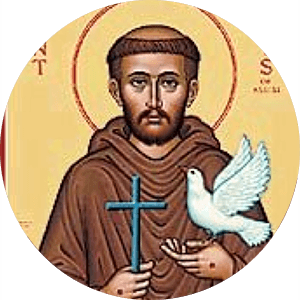
Fr.Raimundo
RED HOUSE – Fr. RAIMUNDO
Fr. Raimundo dos Anjos Beirão – Patron of the Red House He was born in Lisbon, on March 8, 1810. At the age of 16 joins the Third Order Regular of St. Francis of Assisi and takes the name of Friar Raimundo dos Anjos Beirão. He is ordained as a Priest in 1833. Due to the impact of Liberalism he’s forced to abandon the Convent and decides to dedicate himself entirely to preaching, throughout the country. By the Decree of May 6, of 1855, he’s declared Apostolic Missionary, Singer, Musician and publishes some booklets with novenas and based on other religious themes. In the beginning of his Priestly Life, he starts the Association of the Sons of Saint Cajetan – boys whom he educates and who accompany him in questing and distributing among the poor, the alms that were received. The contact with misery causes him to dream about starting a Religious Congregation that would minimize the suffering of the needy. Libânia do Carmo is the instrument that God provides him for the realization of this dream. He dies in the grace of God on the July 13th , 1878, surrounded by the Religious Family founded by him.
Blessed Maria Clara
GREEN HOUSE – Blessed Maria Clara
Mother Maria Clara Do Menino Jesus- Patroness of the Green House
The Church has publicly recognized the servant of the Lord, Sr. Maria Clara do Menino Jesus, as blessed. Born in Amadora, on June 15, 1843, with the name of Libânia do Carmo Galvão Mexia de Moura Telles e Albuquerque. She was the daughter of Nuno Tomás de Mascarenhas Galvão Mexia de Moura Telles e Albuquerque and of Maria da Purificação de Sá Carneiro Duarte Ferreira.
As the third of the seven children of that noble and profoundly Christian family, she was received with deep love. She lived a happy childhood and, right from early days, began to open her heart to the loving presence of God, helped by the Christian witness of her parents. When still an adolescent, she suffered the terrible experience of becoming orphan of both parents. she lives the adventure of progressive immersion in the mystery of Christ and, participating in his compassion, she penetrates in the disconcerting world of human suffering, to illuminate it with joy and to warm it with the tenderness and mercy of God
After a protected and happy childhood in her adolescence she was visited by deep and repeated sufferings. At that time, it was possible to perceive the invitation of the Lord Jesus to the heart of Libania, calling her to follow him by the paths of detachment of the franciscan life. She responds to this appeal, by joining a small and unknown group of franciscan tertiaries, whom Fr. Raimundo dos Anjos Beirão supported with spiritual and material help. There, in a poor convent environment, Libania encounters the Christ of Francis and Clare of Assisi, the poor, humble and crucified Lord. With deep humility, she bent down before the dilacerating sufferings that affected her. She did not lose either her joy or peace, she did not deviate from the activities inherent to her mission and it was with dignity that she carried them out. She did not quit from the commitment of doing everything so that truth might shine out, because she learnt from her Master that only truth sets us free.
Just as the joy of the Spirit dwelt in the heart of the Lord Jesus, many a times causing him to exult before the presence of the Father and of His loving action, so did Sr. Maria Clara bear attractive radiating joy and good humour. In moments of community recreations, some Sisters liked to be by her side, because next to Mother Clara nobody could remain sad, as they affirmed. This joy that arose from the contemplation of the good Lord, led her to express her wonder, during her life, in view of the steadfast and touching discovery of her heart: How good God is! Blessed be God! The filial and loving relationship of Sr. Maria Clara with the Mother of God is filled with tenderness and trust. The Lord Jesus is the Son of the blessed Holy Virgin. The Students belonging to Mother Clara’s House Celebrate their House feast on 15th JUNE EVERY YEAR.

St. Francis
YELLOW HOUSE – St. Francis
St. Francis of Assis- Patron saint of the Yellow House
St. Francis is one saint whom both Catholics and non-Catholics have united in honoring. Certainly no other has so appealed to Protestants and even to non-Christians. And the appeal is timeless: Francis captured the imagination of his contemporaries as well as that of modern men by his unique simplicity and a pure grace of spirit. A classic collection of popular legends, contains charming and beautiful stories of Francis’ love of the poor, of animals, of all nature. In action he was original, in speech picturesque and poetic, yet he was a man utterly inspired by faith in and devotion to the risen Christ.
Saint Francis of Assisi, “the little beggar” is perhaps the most popular saint in history. Francis was born in 1182 in Assisi, Italy and his baptismal name was John, but his father renamed him Franceso, in honor of his love for France. The son of a wealthy merchant, Francis had time and money to host lavish banquets for young nobles who proclaimed him “King of Feasts.” Parties and selling cloth left Francis little time for God.
A handsome, charming and educated young man, he spent his early life leading young nobles to parties. He dreamed of knighthood and longed for the adventurous life of chivalry. In pursuit of that dream, he joined in the war between Assisi and Perugia at the age of 20. Francis reportedly heard the voice of Christ, who told him to repair the Christian Church and live a life of poverty. A further call came in 1205, when, in a dramatic moment of prayer in the abandoned Church of San Damiano, Francis heard a voice coming from the crucifix which challenged him to rebuild the church. At first he thought it meant that he should rebuild San Damiano, so he sold some of his father’s cloth to raise money to build the Church at San Damiano. His father, who was already upset about the life he was leading, took him to court, where was ordered him to pay back the money. Francis complied with a dramatic gesture, renouncing his inheritance and handing his expensive clothing to him as well. Dressed only in a workman’s smock, he left town and spent the next two years as a hermit, taking a vow of poverty and dedicating his life his life to God. Francis begged for his food, wore old clothes, and preached peace. He began to attract followers. Out of humility Francis never accepted the priesthood but remained a deacon all his life. He had a great love for animals. His ardent love of God merited him the name Seraphic.
Francis died at the age of 44 on October 4, 1226 at Portiuncula, Italy. He was canonized by Pope Gregory IX less than two years later. The Students of St. Francis House celebrate their house feast on 4th October.

St. Clare
BLUE HOUSE – St. Clare
St. Clare of Assisi – Patroness of the Blue House
Clare of Assisi was born into a wealthy Italian family but soon shunned her luxurious upbringing to embrace the life of piety and poverty. Inspired by the words of Francis of Assisi, Clare fled her home and joined Francis, establishing her own religious order.Clare was born in Assisi, Italy, in 1193 to wealthy parents, and was taught to read and write as well as spin yarn and do needlework.
She had little interest in her luxurious surroundings (she lived in a palace), and influenced by her mother’s religious devotion, Clare dedicated her life to God at an early age. She also showed early on that her calling would involve helping the poor, as she set aside food from her family table to give to the needy on the streets.
As a child, Clare was devoted to prayer. From her earliest years Clare seems to have been endowed with the rarest virtues. As a child she was most devoted to prayer and to practices of mortification, and as she passed into girlhood her distaste for the world and her yearning for a more spiritual life increased. The inspired words of the Poverello kindled a flame in the heart of Clare; she sought him out secretly and begged him to help her that she too might live “after the manner of the holy Gospel”. St. Francis, who at once recognized in Clare one of those chosen souls destined by God for great things, and who also, doubtless, foresaw that many would follow her example, promised to assist her. Clare continued his work and broadened her own influence. Clare died in 1253 and was canonized two years later by Pope Alexander IV.
The feast of St. Clare is celebrated throughout the Church on 12 August. Later change to 11th August. The Student of St. Clare’s House celebrate their House Feast on 11th August.